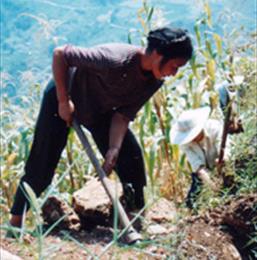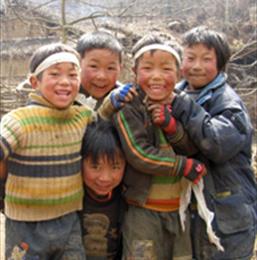Forestry and Animal Husbandry Projects
Along with villagers’ financial ability increasing and development requests increasing, how to increase a family’s income has already become villagers’ urgent concern. The goal of DORS starting these types of projects is to help search and explore together with villagers, methods of increasing their income, and through this to achieve sustainable community development. As a result we have implemented forestry, animal husbandry and agriculture projects.
Forestry
The forestry projects DORS implements mainly include buying or helping villagers buy saplings/seeds, introducing new varieties, and building basic foundations for forestry such as building water cisterns for irrigation on the mountainside, doing forestry training, etc. Through providing technical and financial support we help villagers design, implement and manage their own community forestry projects. This kind of project can give proper attention to agricultural development but at the same time not take up tillable soil (plants are planted under the trees), which achieves the aim of being a good companion system to agriculture. These projects are both useful for local areas’ sustainable income and for reducing mud- and rockslides and otherwise protecting the environment.
In 1998 DORS started doing community forestry projects in poor rural areas. The purpose of the project is through planting appropriate trees, for example, fruit trees, and thereby increasing villagers’ income from the sale of fruit, to expand the forested area in villages—at the same time as we seek to supplement villagers’ income in other ways. Early on forestry was rather separate from other projects, and only in certain households were trees planted. But through continual experimenting and research, the project gradually expanded into an integrated forestry project. This includes basic forestry infrastructure such as: the cisterns for irrigation water on the mountainside; planted fruit trees, other economic-benefit trees, fuelwood trees and trees that produce wood for household use; and forestry training. These are to raise villagers’ economic condition as well as to preserve the environment, in order to give proper attention to to both.
Because local areas lack training relevant to local trees, villagers tend to receive little produce from their non-timber forest trees. Since villagers’ development ideas and attitude determine which projects to do, we decided to implement two large forestry trainings one after the other in 2003 and 2004, and 10-plus small forestry trainings.
To sum up, we provided foundations for villagers’ development of and management of forestry. Up to the end of 2006, in these ten years, DORS has done integrated forestry projects in 16 villages (altogether DORS has implemented projects in 37 villages). DORS supported 567,137 saplings being planted, and at the tail end of the project the growth-to-maturity (survival) rate of the little trees reached over 90%, altogether 6477 villagers having benefited from the project. We spent 896,871 yuan on the project in total; villagers’ own contributions totaled 9,784 yuan, and the government contributed a part, totaling 5,110 yuan. These forestry projects both increase villagers’ income and add green to the environment, which benefits villagers in turn. Forestry is a long-term project, and cyclical, so after every individual forestry project we do an evaluation plus initiate follow-up management, such as coming to know: Did the villagers carefully manage their plants, did they get produce from them, if not, why, etc.
Project Effectiveness
1. The length of time before one sees economic benefit from forestry projects is rather long, but villagers all feel this is a way to increase income, and a way to achieve sustainable development. One of the project villages (Wanlin)’s villagers told us they are preparing to depend on their cherry trees for sustaining their income in their old age! Again, the trees both increase income and protect the environment.
2. Villagers go through technical forestry management training and come to understand the economic benefit of managing their trees well, then through seeing the relationship between careful management and output, gradually change from being compelled from outside to manage their trees to self-motivatedly doing it. Under the leadership of our project, some villagers increased the scope of their cherry and small fruit trees planting on their own, and at the same time took the initiative to ask us technical questions, and ask for pamphlets, etc. on managing the trees.
3. Besides economic-benefit trees, we have promoted planting trees for firewood and household-use wood. At the beginning of 2000, altogether we bought 201 kilograms of different tree types’ seeds (for example: Liushan, Jiasha,Limu). The planted seeds have not yet grown up into forest, but the biggest benefit so far is: for example, in Fuyou village (a project village), villagers requested we help them buy Liushan and Limu seeds to create forest and benefit themselves.
Animal Husbandry
For a lot of our project villages, when we mention development ideas, they all want to develop animal husbandry. Animal-raising projects are designed according to villagers’ requests, our own ability and the local conditions. Projects done include: raising cattle, sheep, goats, pigs, chickens, etc. Project activities have included: building sties, planting grass, improving breeds, managing animals and preventing/treating illness, etc.
DORS started implementing this project in 2001. The first project was the Kadoorie Foundation (of Hong Kong)-supported sties construction project in Chalin village. Sties are the foundational facilities necessary for good animal husbandry. Doing a good job on the sties is the condition for being able to do further good AH projects. Minority villagers (often poorer), especially had sties in poor condition. Animal-raising is a fairly money-intensive project, and due to the fact that villagers typically don’t have technical training in preventing animal diseases, this type of project is risky. It is important to consider carefully in the project planning stage how to reduce this risk. In this project, villagers’ contribution is a larger proportion than in other projects, still calculated according to individuals’ financial ability, but in some villages the village contribution equals half of project funds, which testifies to the high level of interest among the villagers in this type of project. In 2001 we did a large-scale animal husbandry training together with the Animal Husbandry Bureau, and afterwards did a series of small trainings in the villages.
In DORS’ projects, we emphasize that villagers need to contribute a part of the project funds. The reasons are the following: 1, it is a way to increase villagers’ sense of responsibility, because the project is related to oneself, and then each will be more motivated to care for it; 2, it is a way to increase villagers’ participation; and 3, whether villagers are willing to contribute funds also can reflect how important villagers think the project is and just how interested they are in it.
As of March 2007, DORS had altogether implemented AH projects in 13 villages. In total 3799 villagers benefited. We contributed 416,659 yuan to this project; villagers contributed 24,471 yuan; and the government contributed 3,799 yuan.
Project Effectiveness
1. Reconstructing sties: improves animals’ living environment, and improves the sanitation of the villages, with manure easier to collect.
2. Develops the raising of the livestock, increasing villagers’ income, for example: In Sanshihu village in Ganluo, DORS provided 175 ewes, divided among 35 households with repaired sties, and calculating, we supported 5 sheep per household. The project lasted 3 years (in those three years no sheep could be sold), and except for certain sheep which naturally died, etc., three years later, the 5 sheep had increased to 15-20 sheep per household, and the economic benefit rose by 3-4 times.
Horticulture
This project has seen a lot of villager interest this year in particular, for example: planting medicinal plants, moyu, butter beans, etc. In general, according to villagers’ requests and local conditions, we consider helping provide seeds, improving varieties, providing supplementary funds, arranging plant management training, etc. At present the projects in this area are mainly “demonstration” projects, because for this type of projects the government is already investing a lot, for example, medicinal plants. Our influence is just to be a guide. As of the end of 2006, we had only implemented 3 projects in 2 villages, contributing 4855 yuan, and 70 villagers had benefited.
Project Effectiveness
On the condition that villagers are interested in a particular project, we contribute a part of the funds and then experiment and explore together with villagers. Because the projects are all currently demonstration ones, their scope is small, and the benefit isn’t obvious. Because some of the projects are somewhat experimental, while the project is creating benefit it also easily produces problems, for example: Villagers lack scientific raising knowledge, and aren’t entirely familiar with the new varieties, lack effective management practices for them, etc. This will form a good basis for the expansion of the projects after and if they succeed.


